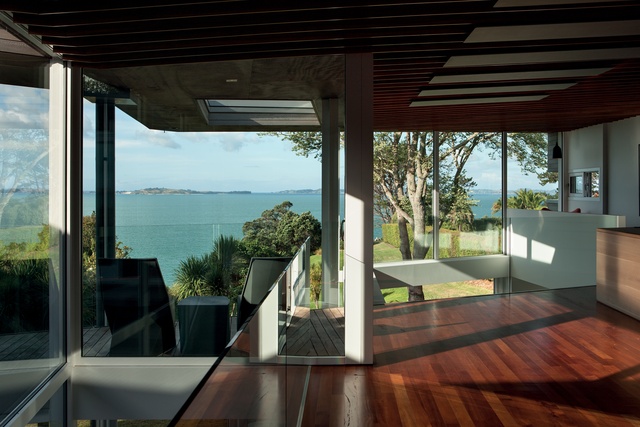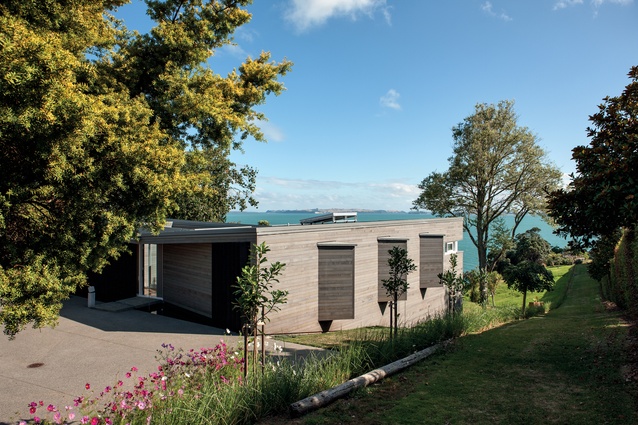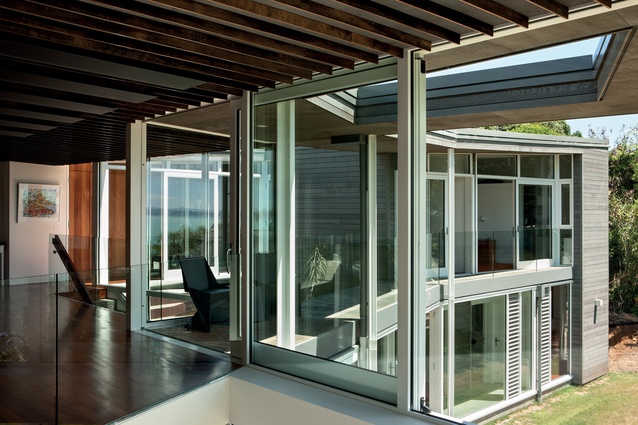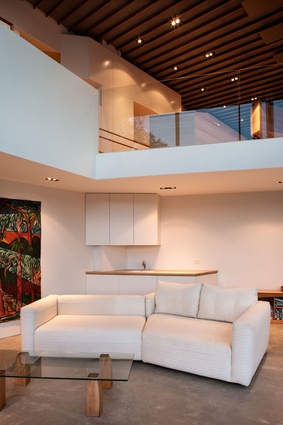Houses revisited: Mellons Bay house
In a city as built-up as Auckland, it can be hard to imagine what came before the suburban sprawl. Looking across rows and rows of houses interrupted only by volcanic cones and water, we can easily forget the native forests that must have grown in between. First published in 2015.
A spring runs beneath the site where this house is built — and to pay homage to it, architect Daniel Marshall has designed the house as a sculptural ode to the waterway below and the sea ahead.
“The house that previously stood on this site was remarkable in that it didn’t have a view of the sea. The site drifts down to a cliff at the end; we did look at putting the house on the cliff, but we pared the plans back and instead looked at it as a reconstructive landscape, a parametric charting of the watercourse on the site. We wanted to look at the way water feeds off the land,” says Marshall.

The first hint of this sculptural intent is at the front door, which is accessed via a bridge over a water feature. Inside, the ‘river’ continues in the form of a water garden created from Corten steel and concrete, which runs down a set of stairs leading to the lawn below. The shape of the timber-framed cedar house continues this theme.
“Thematically, the house is two forms sliding past each other. The internal water feature acts as a separation between these two forms; it is like a room you don’t occupy. In a way, the old house was like a dam,” says Marshall.
The glass front door frames a view of the water, and from inside, the upper living area forms a mezzanine over the lower-level lounge, which opens out onto the lawn through glass sliding doors. This double-height void reinforces the house-as-waterway theme, as the space seems to spill over from the living area to the lounge below. The roof above appears nautical in its pointed shape, directing the gaze towards the sea.

“The main living room skews off from the rest of the grid and rises off from the north side. It lifts its skirts to the sea,” says Marshall. The upper floor has a wood-panelled ceiling, which is reminiscent of the bows of a ship also. Suspended infrared heat panels follow the same lines on the ceiling.

As a public walkway runs along the southern side of the house, windows on this side are enclosed in small alcoves, which provide vignettes of the view without losing privacy. Orange and yellow panels within these alcoves impart an added glow to the living area. This colour scheme is reminiscent of a Mexican hacienda, says Marshall, especially when set against the sleek handle-less lines of the pale-oak kitchen.
“An old oak tree was removed from the site and harvested to create the kitchen at the request of the client. This area was designed to be a sculptural model, a scaled-down version of the house in its entirety.”
Furthering the aquatic theme and in answer to the client’s wish to be environmentally conscious too, a tank was installed under the house to collect rainwater for irrigation.

Given that the property is in a coastal zone, timber joinery seems to be a bold choice. Why did your client want Accoya timber over aluminium? The decision was three-fold. Firstly, timber joinery offers better thermal properties than aluminium. Secondly, its carbon footprint is much lower than that of aluminium and lastly, Accoya is a very stable and durable timber with a longevity similar to a ground treated timber. Also, the client had previously worked with Rennall Doors and was impressed with their recent investment in new machinery.
What is Accoya timber? Accoya is radiata pine that has gone through an acetylation process giving it Class 1 durability — comparable or better than the durability of hardwoods such as Jarrah, Rosewood and Teak. Plus, Accoya wood is non-toxic and doesn’t leech harmful chemicals.
What about ongoing maintenance? There will be more maintenance required compared with aluminium, but even with that factored in, the client felt the benefits of Accoya — such as allowing for finer profiles, which is particularly useful in a high-wind environment — outweighed the negatives.
Click here to see more Houses Revisited. And sign up to our email newsletters to receive Houses Revisited straight to your inbox.
Note: These are stories from our archives and, since the time of writing, some details may have changed including names, personnel of specific firms, registration status, etc.


















